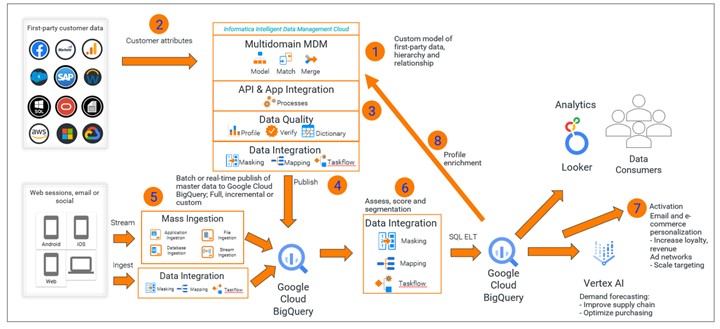Google Cloud Next '23: Want Happy Customers? You Need Trusted Data From Informatica
How to Build a Reliable Data Foundation With Informatica Intelligent MDM and Google Cloud

This blog is co-authored by Monica Mullen, Marketing Director of MDM.
Often, tackling the challenges of consumer marketing is all about understanding how people behave and then creating the personalized experiences that truly connect with them. The tricky part? Sometimes hundreds, even thousands, of data silos within an organization can make it tough to see a complete view of the consumer – what they say and do and how they act and interact across your organization over time. What most modern organizations want — and need — is a solution that brings together all that scattered and fragmented first-party data so they can gain deeper customer insights and find out what really makes them tick.
That’s why many renowned global brands are investing in acquiring and activating first-party data. Additionally, consumer privacy remains paramount. For brands to continue with the development of personalized journeys, they must be adept at safeguarding consumer data. Studies show that consumers are more willing to share personal data in exchange for better customer experiences.
So how do you get there? Navigating modern data challenges involves collecting, transforming, stewarding, analyzing and visualizing data. While first-party data forms the foundation for personalized engagement, stewarding it (centralizing, profiling, enriching, rationalizing, transforming and cleansing) can pose significant hurdles. Integrating and managing diverse data sources while ensuring accuracy and consistency is crucial. The challenge lies in crafting a reliable information framework that supports actionable insights, precise targeting and lasting consumer relationships.
Luckily, you can take advantage of the benefits of Informatica Intelligent Master Data Management (MDM), a service of Informatica Intelligent Data Management Cloud (IDMC), as a core part of your composable customer data platform (CDP) on Google Cloud. Informatica works with Google Cloud to turn your first-party and other data sources into a trusted, governed and compliant view of customers across touchpoints and business processes. This empowers you to improve experiences and resolve friction points with smarter analytics fit for the privacy-centric future of customer engagement.
Let’s explore why Informatica Intelligent MDM is a perfect choice to build a trusted data foundation for an analytics CDP on Google Cloud.
Capabilities of Informatica Intelligent MDM on Google Cloud
Informatica announced the availability of Intelligent MDM on Google Cloud at Informatica World this past May to help enterprises leverage many of the complementary capabilities of MDM, including:
- Flexible data model extensible to support custom attributes. Informatica Intelligent MDM allows extending the pre-built customer data model with additional attributes as needed. Pre-built data models are also included in the extensions offered for MDM. These extensions are designed specifically for certain industries (e.g., financial services and healthcare) and data sources (e.g., SAP and Salesforce) to address business needs and speed up time to value. Once a data model is created, then you can use artificial intelligence (AI) to automate the mapping of the data source to the target as part of the extract and load process.
- Multidomain capabilities. Informatica Intelligent MDM supports virtually any domain — not just customer data –within the same platform and database, so new domains can be easily created. There are many advantages of multidomain, including understanding the relationships between people, places and things, that are mastered within the same powerful and flexible document database.
- Pre-built connectors. With Informatica Intelligent MDM, you can extract first-party data from enterprise data sources and cloud data warehouses with 300+ pre-built connectors. These include your most important systems and applications not typically available in a packaged CDP, such as Salesforce, Marketo, Netsuite, Workday, Oracle, JD Edwards, SAP and IBM DB2. Connectors also allow mastered data to be published back to these same sources, ensuring that the data remains consistent, complete and trustworthy.
- ·Robust data quality. Data cleansing, enriching and validation are provided as services within Informatica Intelligent MDM so that data remains clean, standardized and enriched with additional attributes. Data standardization normalizes data as part of the cleansing process. Some examples include the 5+4 zip code, telephone number formatting and other cleansing assets within the data quality service. Data as a Service (DaaS) validates, verifies and enriches customer contact data, including email, phone and address, which helps companies reach customers and remain off of email blacklists.
- Built-in AI. CLAIRE, the AI engine that powers IDMC, uses machine learning (ML) to train the matching of customer records before merging them to create a golden customer record that’s managed, trusted and authoritative. CLAIRE is also used for automated data discovery, data mapping, profiling, survivorship, as well as rule creation and recommendations for masking, quality and standardization.
- Downstream application integration. You can easily publish those customer golden records to Google BigQuery for easy access by business analysts and data scientists. This provides a trusted data foundation for your composable CDP on Google Cloud.
Incorporating Informatica Intelligent MDM on Google Cloud empowers organizations to harness a comprehensive suite of capabilities that are part of the IDMC platform and available on the Google Cloud Marketplace.
How to Build an Analytics CDP Using Informatica Intelligent MDM and Google Cloud
Now that you understand these capabilities, let’s walk through the steps on how to deliver a trusted data foundation for analytics CDP using Informatica Intelligent MDM.

This diagram shows the steps to build a composable CDP using Informatica Intelligent MDM.
Step 1. First-party data is key to building a CDP. For that reason, it’s best to extract customer data directly from enterprise data sources such as CRM, ERP and SCM, where data is still in its original form prior to being transformed and stored in a data warehouse or data lake.
We recommend that you review those data sources and catalog all customer attributes that you will want to use for creating audiences, segmentation and activation. Model these customer attributes in the person business entity in Informatica Intelligent MDM and the Customer 360 application. Pre-built and custom data quality rules can be applied for each customer attribute so the entered value is validated.
Step 2. Build data integration mapping, mapping task, and taskflow using Informatica Cloud Data Integration, a service of IDMC, to extract from each data source, transform the data, if needed, and load into the person business entity in Informatica Intelligent MDM. Informatica Cloud Data Quality, a service of IDMC, can be used to cleanse data during the data loading process. From there, create an ingress job that executes the taskflow described for each data source.
Step 3. Match and merge customer records into the golden records with Informatica Intelligent MDM; this is similar to unifying customer data in a CDP. Informatica is unique in that both declarative rules can be configured and/or CLAIRE can be used to match records. The ML model of CLAIRE can be trained by subject matter experts, such as a business or marketing analyst, to learn how to match records from different data sources.
To merge customer records from different data sources, survivorship must be configured. Survivorship considers the data source or recency if data is in conflict, changes or degrades. In this configuration, attributes from different data sources can be selected to “survive” the match merge process to create a customer golden record. For example, the billing address should be 100% accurate if the record is coming from a billing system. So, the survivorship for this address should be much higher than addresses from other data sources like an order, shipping system or web form.
Merging is an event and process that can be set up to go through an approval process in Informatica Intelligent MDM that can be automated or manually reviewed based on pre-defined parameters, such as confidence scores.
Step 4. Once the customer golden records are created, you can publish or egress them to Google Cloud BigQuery in real-time or batch.
Step 5. Interaction and transaction data, such as web sessions, email, social data and third-party data, can be loaded directly into Google Cloud BigQuery using Informatica Cloud Data Integration and Informatica Cloud Mass Ingestion.
Step 6. Customer golden records from Informatica Intelligent MDM can be married with activity data from the previous step to assess, score and create segments. Informatica Cloud Data Integration mapping with SQL ELT (also known as advanced pushdown optimization) can generate SQL statements for processing in Google Cloud BigQuery to take advantage of its high-performance compute.
Step 7. Segments data can be activated and used by downstream systems to email, mail or send to ad networks. In addition, Looker can use the dataset for marketing and consumer analytics, or Vertex AI for demand forecasting.
Step 8. Relevant attributes from this dataset (such as segment tags; recency, frequency, monetary [RFM] values, risk, churn or propensity scores) can also be used to enrich the golden records in Informatica Intelligent MDM, if wanted, by creating an ingress job and its corresponding mapping, mapping task and taskflow in Informatica Cloud Data Integration. These attributes can then be published to other downstream systems directly from Informatica Intelligent MDM in batch or real-time.
Voila — you now know how to turn your first-party and other data sources into a trusted, governed and compliant view of customers across touchpoints and business processes. If you have the right solutions in place, it should be a straightforward process. Informatica Intelligent MDM on Google Cloud provides data you can rely on for making pivotal business decisions. Available as a service on Google Cloud Marketplace, Informatica Intelligent MDM and IDMC empower you to deliver the great experiences and smarter analytics necessary for the privacy-centric future of customer engagement.
What’s Next?
Do you want to build a composable CDP or learn more about Informatica Intelligent MDM? Check out these resources:
- Going to Google Cloud Next '23 in San Francisco on August 29–31? Swing by our booth to see how our latest innovations can help advance your data success.
- Learn how to accelerate your digital business with 360-degree insights with Informatica Intelligent MDM on Google Cloud.
- Explore how Informatica and Google Cloud work together to power smarter analytics.








